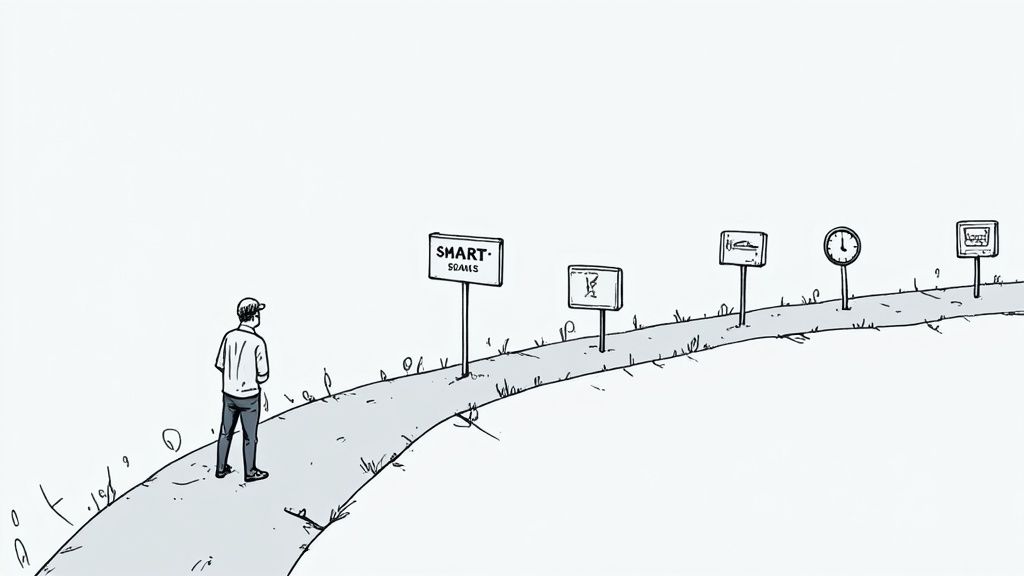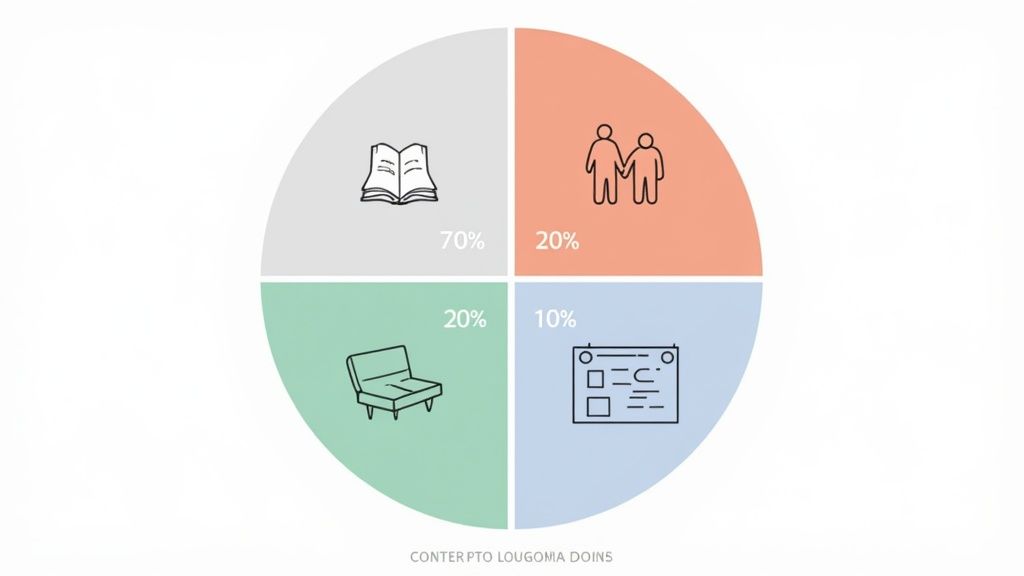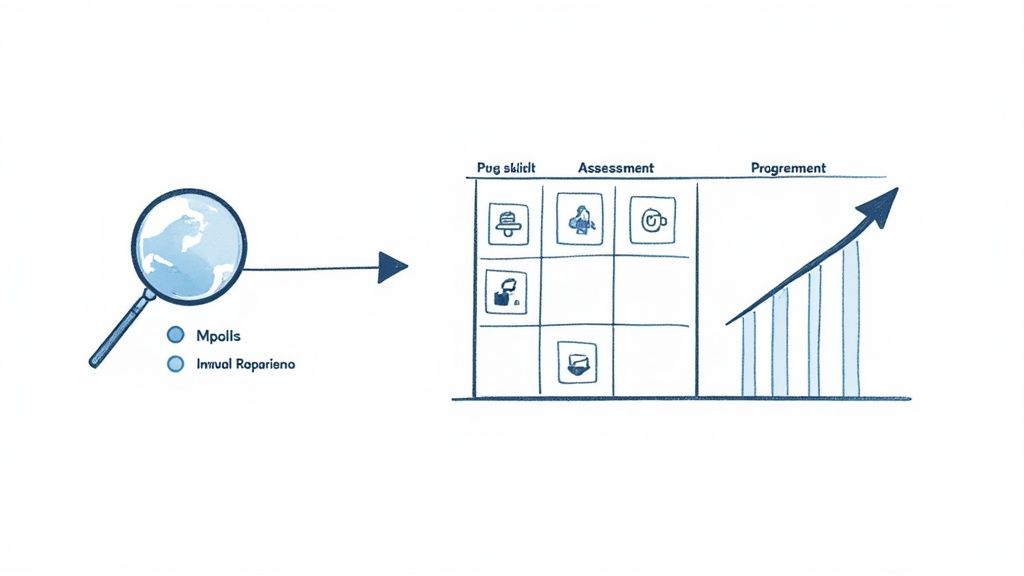8 Professional Development Plan Examples for Career Success


Ready to Grow? Explore These Development Plans
Professional development has a rich history, starting with the traditional apprenticeship models of centuries past that served as early mentorship frameworks. Over decades, this foundation evolved into the formal development plans used by organizations today. This progression mirrors advances in management theory - from Frederick Taylor's scientific principles to modern approaches focused on individual growth and potential.
A successful development strategy combines three key elements: thorough self-assessment, skill building in targeted areas, and concrete action steps that serve both personal and company objectives. Whether you're a coach guiding others or an individual planning your own path forward, understanding these fundamentals is essential for creating meaningful change.
The goal of this article is to help you craft an effective growth strategy by examining 8 distinct professional development plan examples. You'll discover practical approaches for:
- Identifying your key areas for improvement
- Setting realistic and achievable goals
- Measuring and tracking your progress
- Creating sustainable changes that stick
By studying these proven models and understanding the principles behind them, you'll be equipped to design a personalized roadmap for your professional journey. Let's explore how to turn your career aspirations into tangible achievements through deliberate, structured development.
1. SMART Goals Framework
The SMART Goals Framework provides a clear path for professional development by turning abstract career goals into actionable steps. This approach uses the SMART criteria - Specific, Measurable, Achievable, Relevant, and Time-bound - to create well-defined objectives that lead to real progress.

Core SMART Components
- Specific: Set clear, focused goals. Rather than "get better at public speaking," aim for "deliver 15-minute presentations without notes."
- Measurable: Include concrete metrics to track success. Examples: "increase client retention by 20%" or "complete four industry certifications."
- Achievable: Choose goals within reach. Push yourself while staying realistic about your current skills and resources.
- Relevant: Align goals with your career path and company needs. Each goal should meaningfully advance your professional growth.
- Time-bound: Add target dates to create momentum. For instance: "earn project management certification by June 2024."
Key Features
The framework offers practical tools for success:
- Easy-to-use template built on SMART principles
- Clear tracking methods to monitor progress
- Structured timelines with key checkpoints
- Results you can measure and verify
Advantages
- Clear structure eliminates confusion
- Simple progress tracking enables quick adjustments
- Proven record of success across industries
- Common language helps teams align goals
Limitations
- May restrict creative objectives
- Can oversimplify complex growth areas
- Sometimes emphasizes end results over learning process
History and Development
While several people shaped the SMART concept, Peter Drucker laid important groundwork through his Management by Objectives work. George T. Doran later refined and documented the SMART approach in his 1981 paper about management goals.
Real Examples
- Google uses a modified version called OKRs (Objectives and Key Results) to connect individual and company goals
- Intel applies SMART principles to employee development and performance reviews
Implementation Tips
- Begin with broad objectives, then refine using SMART criteria
- Review goals every three months to maintain relevance
- Mix short and long-term goals for balanced development
Why It Works
The SMART Goals Framework stands out because it consistently helps people achieve their professional aims. Its clear guidelines and focus on measurable outcomes make it valuable for both coaches and individuals. By providing specific steps for growth, SMART goals help professionals take charge of their career progress.
2. 70-20-10 Learning Model

The 70-20-10 Learning Model is one of the most well-tested frameworks for professional development. Created by researchers at the Center for Creative Leadership, this model shows that most learning happens through three key channels: 70% through hands-on experience, 20% through social connections, and 10% through formal education.
Key Components:
- 70% Learning by Doing: Focuses on active learning through projects, new responsibilities, and real-world practice. This hands-on approach builds deep skills and practical knowledge.
- 20% Learning from Others: Involves growth through mentorship, peer feedback, and networking. Regular discussions with colleagues and learning from role models help develop key abilities.
- 10% Formal Training: Includes structured programs like courses, workshops, and training sessions. While smaller in proportion, this foundation supports the other learning types.
Main Benefits:
- Deep understanding through practice
- Better problem-solving skills
- Higher engagement levels
- Faster skill development
- Natural knowledge retention
Advantages:
- Evidence-based: Built on solid research and proven results
- Well-rounded: Works for different learning preferences
- Budget-friendly: Reduces formal training costs
- Action-focused: Centers on real work applications
Potential Challenges:
- Not ideal for those who prefer structured learning
- Needs strong company support
- Progress can be hard to measure
- Requires active participation
Success Stories:
Major companies like Morgan Stanley and Nike use this model to grow their teams. They combine work projects, mentoring programs, and focused training to build skills and drive results.
Implementation Tips:
- Create challenging projects that push people to grow
- Set up strong mentoring connections
- Schedule time for reflection and feedback
- Track progress through regular check-ins
- Keep formal training focused and relevant
The 70-20-10 model offers a practical path to professional growth. By focusing mostly on real experience while including social learning and formal training, it creates lasting development that directly improves work performance.
3. Individual Development Plan (IDP)
An Individual Development Plan (IDP) helps professionals chart their career growth systematically. It documents personal career goals, needed skills, and concrete steps to develop those capabilities. Unlike a resume that looks backward, an IDP focuses on future growth. Creating an IDP together with a supervisor helps align personal development with company objectives.
The Value of IDPs:
Professional development has become crucial for long-term success in any career. An IDP brings structure and clarity to this process by translating career aspirations into specific action steps. The organized approach makes it easier to track progress, while collaborative planning strengthens relationships between employees and managers.
Key Elements and Advantages:
- Skills Assessment: IDPs start by evaluating current capabilities versus those needed for target roles. This identifies key areas for focused learning.
- Career Planning: Looking beyond immediate needs, IDPs help map out long-term career directions and milestones.
- Action Steps: The plan converts goals into concrete activities like training, mentoring, projects, and job shadowing.
- Progress Reviews: Regular check-ins, often quarterly, help track advancement and adjust plans. This feedback cycle keeps development on track.
Benefits:
- Custom Fit: Each IDP addresses unique individual goals and needs
- Clear Ownership: Regular reviews and defined steps build responsibility
- Career Growth: Focused skill building opens paths to advancement
- Better Communication: Joint planning improves manager-employee relationships
Potential Challenges:
- Time Required: Creating and maintaining a thorough IDP takes significant effort
- Sustained Focus: Success depends on steady dedication to development activities
- Rapid Change: Skills requirements evolve quickly in many fields, requiring frequent updates
Real-World Applications:
IDPs are widely used across sectors. Government agencies like the Department of Defense and National Institutes of Health rely on IDPs for employee development. Private companies like Microsoft integrate IDPs into career frameworks. Their growing adoption reflects increased focus on continuous learning.
Implementation Tips:
- Review Quarterly: Regular IDP updates help adapt to changing goals and industry needs
- Include All Skills: Cover both technical abilities and key soft skills like communication
- Support Company Goals: Connect personal development to organizational objectives
Following these guidelines helps individuals and organizations use IDPs effectively to drive professional growth and career advancement.
4. Competency-Based Development Plan
A Competency-Based Development Plan creates a focused path for professional growth by centering on specific skills and knowledge needed for current or future roles. This targeted method offers clear direction for skill building that aligns with performance objectives. The focus on measurable abilities makes it valuable for both individuals and organizations.

Core Components
The process starts with competency mapping to identify essential skills for a role, often using established industry frameworks. Next, assessment tools like self-evaluations, 360-degree feedback, and skills tests measure current abilities. The gaps between present and desired skill levels guide the selection of development activities - from training to mentoring to hands-on projects. A progress tracking system monitors growth and enables adjustments.
Historical Context
This approach gained momentum in the late 20th century as businesses recognized the need to connect individual growth with company goals. The shift toward knowledge work and rapid tech changes drove demand for focused skill development. Many organizations now use this method, particularly in fast-moving industries.
Key Elements
- Competency Mapping: Clearly outlines needed skills
- Assessment Tools: Measures current abilities objectively
- Development Activities: Provides targeted learning experiences
- Progress Tracking: Monitors advancement and enables course correction
Advantages
- Direct skill focus: Takes the guesswork out of development planning
- Clear measurement: Uses consistent criteria to evaluate progress
- Business alignment: Builds capabilities that drive organizational success
Challenges
- Setup complexity: Requires careful planning and framework selection
- Keeping current: May lag behind newest skill requirements
- Maintenance needs: Models need regular updates to stay relevant
Real-World Examples
- Deloitte's framework emphasizes leadership, business knowledge, and technical expertise
- IBM's program helps employees spot skill gaps and access learning resources
Implementation Tips
- Use proven industry frameworks as reference points
- Schedule regular skill assessments
- Connect development goals to performance reviews
This method deserves attention because it creates a focused and measurable approach to professional growth that directly supports both individual and organizational needs. For coaches and development professionals, it provides a practical framework to help clients build meaningful skills.
5. Agile Development Plan
The Agile Development Plan takes principles from software development and applies them to professional growth. This method focuses on adaptability, ongoing feedback, and quick adjustments based on changing needs. Unlike traditional fixed plans, it promotes constant learning and quick responses to new opportunities.
This approach stands out because it offers both structure and flexibility for ongoing development. It recognizes that professional growth rarely follows a straight path and encourages regular skill assessment to stay competitive.
Key Features of an Agile Development Plan:
- Sprint-based learning cycles: Break down goals into small 2-4 week focused learning periods
- Regular reviews: Schedule feedback sessions to assess progress and needed adjustments
- Flexible planning: Modify plans based on sprint results and changing goals
- Ongoing feedback: Get input from mentors and colleagues to improve learning
Pros:
- High flexibility: Easy to adjust as circumstances change
- Quick adaptation: Allows rapid shifts based on feedback
- Promotes growth: Builds habit of continuous improvement
Cons:
- Less structured: May challenge those who prefer fixed plans
- Time investment: Regular reviews require dedicated effort
- Cultural fit: Works best in organizations that welcome experimentation
Real-World Examples:
- Spotify's Engineering Growth Framework: Engineers shape their learning paths aligned with team needs
- Atlassian's Development Approach: Uses agile principles to build a learning culture
Implementation Tips:
- Start with short 2-4 week learning sprints to build momentum
- Schedule regular check-ins with mentors
- Keep a prioritized list of development goals
Background:
The Agile Development Plan comes from the Agile Manifesto, created by the Agile Alliance. While it began in software development, agile methods now help professionals in many fields manage their growth and adapt to workplace changes. The approach provides a practical framework for continuous skill development.
6. Career Ladder Development Plan
A Career Ladder Development Plan maps out the steps needed for professional advancement within an organization. It details the specific skills, experience, and achievements required to progress to higher roles over time. This practical tool gives both employees and organizations a shared understanding of what it takes to grow professionally.
Key Components:
- Advancement Paths: Shows the typical progression from entry-level through senior positions within each career track
- Role Requirements: Lists the expected competencies, qualifications, and performance benchmarks at each level
- Skills Framework: Breaks down required abilities by category (technical, leadership, communication) to help identify gaps and growth areas
- Timing Guidelines: Provides approximate timeframes for moving between levels to set realistic expectations
Benefits:
- Clear Direction: Takes the guesswork out of what's needed to advance
- Objective Standards: Uses consistent criteria for promotions across the organization
- Increased Engagement: Gives employees concrete goals to work toward
Potential Limitations:
- Rigidity: Traditional ladder structures may not fit those seeking non-traditional career paths
- Limited Movement: Focus on upward progression can overlook valuable lateral opportunities
- Keeping Current: Must be regularly updated as skill requirements evolve
Real-World Examples:
- Google's Engineering Framework: Details progression from entry-level to distinguished engineer with specific expectations at each step
- Meta's Technical Career Path: Outlines advancement options and requirements for technical roles
Implementation Tips:
- Regular Updates: Review and refresh the framework annually to reflect industry changes
- Multiple Pathways: Include options for specialists, project roles, and lateral moves
- Individual Adaptation: Allow for personalized timing and paths based on unique strengths
While a Career Ladder Plan requires ongoing maintenance to stay relevant, it remains a valuable tool for professional development. The key is building in enough flexibility to accommodate different career goals while maintaining clear standards for advancement. When thoughtfully designed and regularly updated, it helps both employees and organizations plan for long-term growth and success.
7. Learning Portfolio Plan
A Learning Portfolio Plan helps professionals track and showcase their development journey. It's a collection of experiences, achievements, and insights that tell the story of your professional growth. Like a living resume, it grows and changes as you gain new skills and expertise.

While portfolios have long been standard in design and education fields, the concept of learning portfolios for broader professional development has gained ground recently. This shift reflects growing awareness that traditional resumes often can't fully capture someone's skills and experiences. Professionals now seek better ways to document their ongoing learning and growth.
Key Features of a Learning Portfolio Plan:
- Evidence Collection: Include certificates, project samples, presentations, and performance reviews that demonstrate your learning
- Reflection Components: Write about your key takeaways and growth through reflective essays or journal entries
- Achievement Documentation: Record accomplishments like awards, promotions, successful projects, and positive feedback
- Skill Demonstration: Show your abilities through practical examples and case studies
Pros:
- Complete Documentation: Gives a full picture of your professional path
- Deepens Learning: Encourages reflection and self-awareness
- Shows Progress: Makes skill development visible over time
Cons:
- Takes Effort: Requires ongoing updates and maintenance
- Can Get Messy: Needs good organization to stay manageable
- Regular Updates: Must be kept current to be useful
Real-World Examples:
- Teaching Portfolios: Show teaching philosophy, lesson plans, student work examples
- Design Portfolios: Present creative work and design process
- Developer Portfolios: Feature coding projects and technical capabilities
Tips for Success:
- Regular Reviews: Set aside time each quarter to update and refresh
- Digital System: Use cloud storage or portfolio platforms to organize materials
- Add Reflection: Don't just collect items - write about what you learned and how you'll apply it. Ask yourself: "What did this teach me?", "How did I use this learning?", "What's my next step?"
A well-maintained Learning Portfolio Plan helps professionals track their growth and effectively share their expertise with others. It's a valuable tool for anyone serious about their ongoing development.
8. Mentorship-Based Development Plan
A mentorship-based development plan creates structured relationships between experienced professionals and those seeking growth. It combines one-on-one guidance, networking, and hands-on learning to help people reach their career goals. Through these partnerships, senior professionals share their expertise to guide and support more junior colleagues.
While informal mentoring has existed throughout history, organizations began formally integrating mentorship programs in recent years after seeing clear benefits for knowledge sharing and employee development. Many companies now consider mentorship a core part of their development strategy due to growing demand for personalized learning paths.
Key Features of a Mentorship-Based Development Plan:
- Compatible Matching: Carefully pairing mentors and mentees based on skills, experience levels, and development needs
- Clear Goals: Setting specific, measurable objectives at the start of the mentorship relationship
- Regular Meetings: Scheduling consistent check-ins to track progress and provide ongoing support
- Skills Transfer: Sharing practical knowledge and best practices to accelerate learning
Pros:
- Individual Focus: One-on-one guidance customized to each person's needs and goals
- Expert Insights: Direct access to leaders who have navigated similar career paths
- Network Growth: Connections to new professional opportunities and relationships
- Practical Learning: Safe environment to apply skills and get constructive feedback
Cons:
- Mentor Time Constraints: Good mentors can be hard to find and secure commitments from
- Inconsistent Quality: Success depends heavily on the mentor's capabilities and dedication
- Limited Perspectives: Internal programs may not expose mentees to diverse viewpoints
Real-World Examples:
- GE's Leadership Programs: Long-running initiative matching emerging leaders with senior executives
- McKinsey's Mentoring System: Structured program guiding consultants through career advancement
Tips for Success:
- Clear Agreements: Define roles, expectations and commitments upfront
- Consistent Schedule: Block regular meeting times to maintain momentum
- Multiple Mentors: Build relationships with several mentors for varied perspectives
- Progress Tracking: Keep notes on key learnings and action items
This approach works because it creates meaningful connections focused on growth. A well-designed mentorship program helps people learn faster by leveraging experienced guides. Understanding the core elements, benefits and potential challenges enables organizations to build mentoring relationships that advance both individual careers and company goals.
8-Plan Professional Development Comparison
| Plan | Implementation Complexity 🔄 | Resource Requirements ⚡ | Expected Outcomes 📊 | Ideal Use Cases 💡 | Key Advantages ⭐ |
|---|---|---|---|---|---|
| SMART Goals Framework | Moderate – structured templates & clear milestones | Low – minimal tracking tools | Measurable growth with clear deliverables | Organizations with defined, outcome-based objectives | Clarity, proven effectiveness, and widespread acceptance |
| 70-20-10 Learning Model | Moderate – blended experiential, mentoring & formal training | Medium – requires organizational support & mentorship | Holistic development with practical skill gains | Dynamic environments emphasizing on-the-job learning | Balanced, research-backed, and cost-effective |
| Individual Development Plan (IDP) | High – personalized planning with ongoing reviews | Medium – collaborative input and time investment | Tailored career progression and skill growth | Employee-manager collaborative settings | Customization, accountability, and comprehensive planning |
| Competency-Based Development Plan | High – involves detailed competency mapping & regular updates | High – requires specialized assessment tools & frameworks | Objective skills development aligned with business needs | Skill-critical roles within enterprise settings | Clear competency focus, objective criteria, and business alignment |
| Agile Development Plan | Low to Moderate – iterative sprints with continuous feedback | Low – leverages existing agile practices | Rapid, adaptive learning and swift course corrections | Fast-paced, change-prone environments | Flexibility, responsiveness, and continuous improvement |
| Career Ladder Development Plan | Moderate – defined levels with structured progression | Medium – demands systematic framework updates | Transparent career advancement and skill milestones | Organizations with clearly structured career paths | Clear progression, motivational clarity, and transparency |
| Learning Portfolio Plan | High – requires comprehensive documentation and reflection | High – time-intensive maintenance and regular updates | In-depth evidence of professional growth and competency | Roles valuing reflective practice and detailed records | Holistic documentation, self-reflection, and demonstrable skills |
| Mentorship-Based Development Plan | Moderate – structured mentor matching and regular check-ins | Medium – depends on mentor availability and scheduled interactions | Personalized guidance and network expansion | Organizations fostering strong mentor-mentee relationships | Personalized approach, experiential learning, and network building |
Chart Your Course: Building Your Ideal Development Plan
Professional development requires a thoughtful approach tailored to your unique goals and learning style. I'll walk you through eight proven development models that can help guide your growth journey. From the structured SMART Goals Framework and 70-20-10 Learning Model to more flexible options like the Agile Development Plan and Mentorship-Based Plan, each offers distinct advantages. Understanding these different approaches allows you to craft a development strategy aligned with your career vision and preferred learning methods.
Creating an effective plan starts with honest self-assessment. Take time to evaluate your current skillset and identify specific areas for improvement. Choose the development framework that best matches your needs, then break it down into concrete, achievable milestones with clear timelines. Regular progress checks help you celebrate wins and adjust course as needed based on what's working and what isn't.
Success requires embracing diverse learning opportunities and maintaining curiosity about your field. Take advantage of online courses, workshops, conferences and knowledge-sharing with peers. View challenges as chances to build new capabilities. Stay informed about key industry developments that could impact your professional growth, like emerging AI coaching tools, growing emphasis on emotional intelligence, and evolving coaching specialties.
Key Takeaways:
- Personalization: Select a development approach that fits your individual learning preferences and goals
- Actionable Steps: Create clear, manageable milestones to track progress
- Continuous Improvement: Regularly assess and refine your plan based on results
- Embrace Change: Keep up with important industry trends and developments
Ready to take your professional development to new heights? Coaching Hub provides actionable insights, proven techniques, and inspiring stories to support coaches and anyone focused on personal and professional growth. Visit today to access resources that will help you reach your full potential!